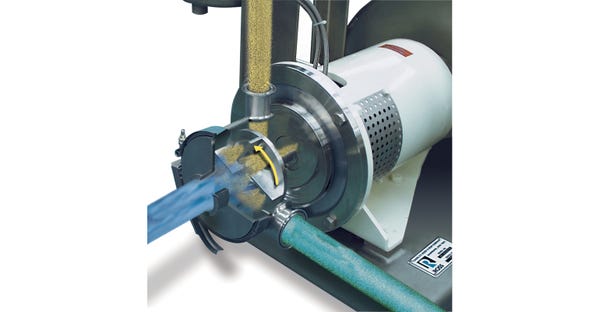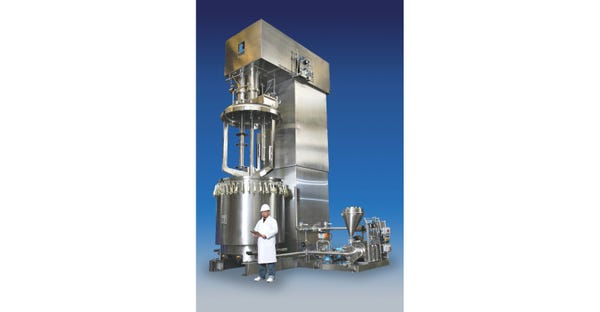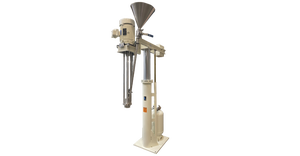The difficulties of combining dry and wet components impose several constraints.
January 23, 2023

Erin Dillon, media & marketing coordinator, Charles Ross & Son Co.
Following the pandemic's supply chain disruptions and increased raw material pricing, manufacturers will prioritize cost savings and efficiency in 2023. One key issue that customers repeatedly ask is how can they quickly and effectively introduce powdered ingredients into liquid. The difficulties of combining dry and wet components impose several constraints. Minimizing dust and avoiding airborne hazards is one concern. Creating a uniform mixture -- whether it’s a dispersion or solution – by applying the appropriate amount of shear is another. Incorporating hydrophobic powders in an aqueous vehicle presents another layer of complexity because they resist wet-out and form stubborn agglomerates also known as "fish eyes".
Processing Struggles and Workaround
Operators develop workarounds to achieve their mixing goals, such as the time-consuming process of sifting powders and slowly adding them to the batch, or adding powders quickly and shearing the batch to break down agglomerates. In extreme cases, operators resort to overcharging solids and straining out the inevitable lumps that remain undispersed even after an excessive duration of mixing. Not only is this process laborious, but it also wastes costly raw materials and energy, while compromising formulation integrity between batches.
With certain thickening ingredients, if powders are charged too slowly, an uncontrolled viscosity build-up can occur in the middle of the process, preventing the remaining solids from being fully incorporated. On the other hand, if powders are added too fast into the surface of a batch under turbulent flow conditions, the process becomes prone to dusting and floating powders. Also, aggressive mixing could overshear already hydrated particles. Prolonged intense mixing may result in permanent viscosity loss or other undesirable rheological properties.
In addition to the previously described workarounds, some manufacturers have adopted eductor systems to improve powder induction into liquid. In these systems, liquid is pumped at high velocity into a venturi chamber and then into an inline mixer. Vacuum created in the venturi chamber draws powders from an overhead hopper and into the eductor, where it joins the liquid flow. The powder and liquid streams are then mixed by a rotor/stator device, which propels the flow downstream. While this configuration eliminates the dusting and floating problems associated with batch systems, it has drawbacks. For one, the system typically requires substantial maintenance with three separate devices in series. Balancing the performance of the pump, eductor, and mixer is frequently difficult, and downtime is quite high in many applications. The most serious limitation is related to the venturi or eductor's inherent operating limitations as clogging is very common. The system is temperamental and requires a lot of operator experience and attention to work properly. Because the feed rate of the eductor is determined by the vacuum created by a fast-moving stream, it is also highly viscosity-dependent. The eductor's efficiency decreases steadily as viscosity increases until it finally stops.
Advances in Powder Induction Technology
When large amounts of powders need to be added in bulk, or when hard-to-disperse solids take too long to completely wet out even with a high-speed blade, a rotor/stator mixer with built-in powder induction capability is worth considering.
One example is the Ross Solids/Liquid Injection Manifold (SLIM) System. It introduces powders like fumed silica, calcium carbonate, gums, starches, and pigments into the liquid phase right in the high-shear zone, promoting instant wet-out. Dispersions and solutions are created in less time compared to the traditional methods of adding powders on top of an agitated batch, or using an eductor. Utilizing a specially engineered rotor/stator mixer, the SLIM technology generates an intense vacuum in the high-shear zone and sucks in powders into a fluid stream – dry and wet materials are combined at the exact point where intense mixing takes place, not in an upstream eductor. This allows the SLIM to handle large volumes of solids without clogging or agglomerates. Another benefit is the relatively dust-free operation – operators report a significant reduction of airborne particles in the mixing area.



Sub-Surface Powder Induction in Batch Mixers
The SLIM technology is available in batch configuration as well. Batch high-shear mixers (also sometimes called homogenizers) with a rotor/stator mixing head are commonly used for wetting out powders and preparing fine dispersions. The four-blade rotor runs at tip speeds around 3,000-4,000 ft/min within a close tolerance fixed stator. This generates mechanical and hydraulic shear by drawing product components into the rotor and expelling them radially through stator openings. For improved efficiency, this style of mixer can be supplied with built-in powder induction feature. The batch SLIM, for instance, introduces solids sub-surface, eliminating floating powders and promoting instantaneous dispersion.

Batch SLIM designs on a lift for use with multiple vessels (left) and fixed-mounted to a tank (right)
Erin Dillon is media & marketing coordinator, Charles Ross & Son Co. (Hauppauge, NY). For more information, call 631-234-0500 or visit mixers.com.
You May Also Like


